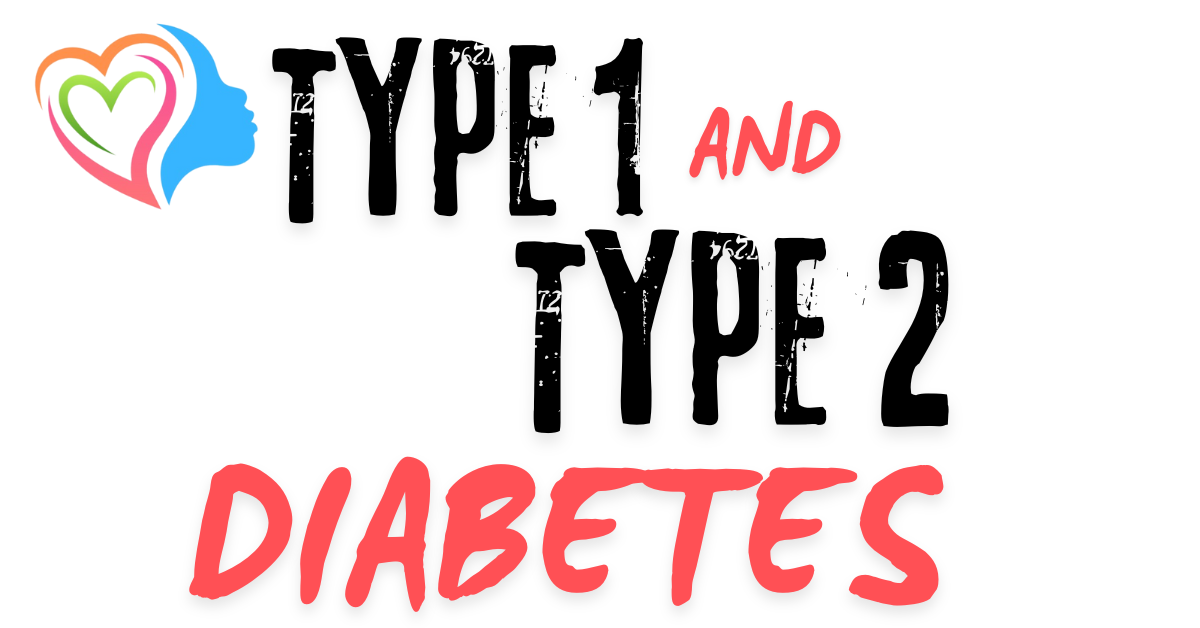
Type 1 and Type 2 Diabetes
Diabetes is a chronic health condition that affects how your body turns food into energy. The main feature of diabetes is elevated blood sugar levels, which can lead to severe health issues over time if not managed properly. There are two primary types of diabetes: Type 1 and Type 2 Diabetes, each with distinct causes and treatment approaches.
Explanation of Blood Sugar Regulation and the Role of Insulin
The pancreas plays a crucial role in blood sugar regulation by producing insulin, a hormone that helps glucose from food enter cells for energy. In people with diabetes, this process is disrupted. In Type 1 diabetes, the body does not produce insulin, whereas, in Type 2 diabetes, the body either resists insulin or doesn’t produce enough of it.
Understanding Type 1 Diabetes
Causes and Risk Factors
Type 1 diabetes is an autoimmune condition where the immune system mistakenly attacks and destroys insulin-producing beta cells in the pancreas. The exact cause is unknown, but genetic factors and certain viral infections are believed to contribute to the risk.
How the Immune System Attacks Insulin-Producing Cells
In Type 1 diabetes, the immune system’s malfunction causes it to target the beta cells, leading to their gradual destruction. This autoimmune attack can happen over months or years before symptoms appear.
Typical Age of Onset and Demographics
Type 1 diabetes often develops in children, teenagers, and young adults, though it can occur at any age. It accounts for about 5-10% of all diabetes cases.
Symptoms and Diagnosis
Common symptoms of Type 1 diabetes include increased thirst, frequent urination, unintended weight loss, extreme hunger, fatigue, and blurred vision. Diagnosis typically involves blood tests to check blood sugar levels and the presence of autoantibodies.
Treatment Options, Including Insulin Therapy and Lifestyle Adjustments
Managing Type 1 diabetes requires lifelong insulin therapy, administered through injections or an insulin pump. Patients must also monitor their blood sugar levels regularly, maintain a healthy diet, engage in regular physical activity, and manage stress.
Understanding Type 2 Diabetes
Causes and Risk Factors
Type 2 diabetes is primarily associated with lifestyle factors and genetics. Key risk factors include obesity, physical inactivity, poor diet, and a family history of diabetes. Age and ethnicity also play roles, with higher prevalence in older adults and certain ethnic groups.
The Role of Insulin Resistance and Beta-Cell Dysfunction
In Type 2 diabetes, the body’s cells become resistant to insulin, and the pancreas can’t produce enough insulin to overcome this resistance. Over time, beta-cell function deteriorates, exacerbating the condition.
Typical Age of Onset and Demographics
Type 2 diabetes is more common in adults over 45, but it’s increasingly diagnosed in younger populations due to rising obesity rates. It constitutes about 90-95% of all diabetes cases.
Symptoms and Diagnosis
Symptoms of Type 2 diabetes often develop slowly and can include increased thirst, frequent urination, hunger, fatigue, and blurred vision. Diagnosis involves blood tests to measure blood glucose levels, such as fasting blood sugar tests and A1C tests.
Treatment Options, Including Medication, Diet, and Exercise
Managing Type 2 diabetes typically involves lifestyle changes like a healthy diet, regular physical activity, and weight management. Medications, such as metformin, can help control blood sugar levels. In some cases, insulin therapy may be necessary.
Key Differences Between Type 1 and Type 2 Diabetes
Causes and Underlying Mechanisms
The primary difference between Type 1 and Type 2 diabetes lies in their causes. Type 1 is an autoimmune disorder, while Type 2 is linked to insulin resistance and beta-cell dysfunction.
Age and Demographic Differences
Type 1 diabetes usually appears in younger individuals, whereas Type 2 diabetes is more common in adults, although it is becoming more prevalent among children and adolescents.
Differences in Symptoms and Progression
While both types share common symptoms like increased thirst and urination, Type 1 symptoms often appear suddenly, whereas Type 2 symptoms develop more gradually. Type 1 diabetes requires immediate insulin therapy, while Type 2 can often be managed initially with lifestyle changes and oral medications.
Treatment Approaches and Management Strategies
Type 1 diabetes management focuses on insulin therapy, while Type 2 diabetes management includes lifestyle modifications, oral medications, and sometimes insulin. Both types require regular monitoring and a healthy lifestyle.
Common Myths and Misconceptions
Addressing Common Myths About Type 1 and Type 2 Diabetes
One common myth is that eating too much sugar causes diabetes. While diet plays a role in Type 2 diabetes, it is not a direct cause of Type 1 diabetes. Another myth is that people with diabetes need to follow a strict diet, whereas a balanced diet is beneficial for everyone.
Clarifying Misconceptions About Causes, Treatments, and Lifestyle Impacts
It’s also a misconception that only overweight people get Type 2 diabetes. While obesity is a significant risk factor, genetics and other factors contribute to the disease. Additionally, people often think insulin is only for Type 1 diabetes, but it can also be essential for managing Type 2 diabetes.
Living with Diabetes
Personal Stories and Testimonials from People with Type 1 and Type 2 Diabetes
Living with diabetes requires continuous management and adjustment. Personal stories often highlight the challenges and triumphs individuals face, emphasizing the importance of support networks and self-care.
Daily Management and Coping Strategies
Daily management involves regular blood sugar monitoring, adhering to medication schedules, maintaining a balanced diet, and staying physically active. Stress management techniques, like mindfulness and relaxation exercises, are also crucial.
Importance of Support Networks and Healthcare Professionals
Support from family, friends, and healthcare professionals is vital for managing diabetes. Support groups and counseling can provide emotional support and practical advice, helping individuals cope with the condition.
Recent Advances in Diabetes Research and Treatment
Latest Research Findings and Medical Advancements
Recent research has focused on finding better ways to prevent, treat, and manage diabetes. Advances include new insulin formulations, continuous glucose monitoring systems, and artificial pancreas technology.
New Treatment Options and Technologies
Innovative treatments like SGLT2 inhibitors and GLP-1 receptor agonists offer new ways to manage blood sugar levels. Additionally, technologies like insulin pumps and continuous glucose monitors make diabetes management more convenient and effective.
Future Directions in Diabetes Care and Potential Cures
Future research aims to develop more effective treatments and potential cures, such as beta-cell transplantation and gene therapy. Ongoing studies are also exploring ways to prevent the onset of diabetes in high-risk individuals.
Prevention and Risk Reduction for Type 2 Diabetes
Strategies for Reducing the Risk of Developing Type 2 Diabetes
Preventing Type 2 diabetes involves lifestyle changes such as maintaining a healthy weight, eating a balanced diet, and engaging in regular physical activity. Avoiding tobacco use and limiting alcohol consumption can also reduce risk.
Importance of a Healthy Diet, Regular Exercise, and Weight Management
A diet rich in fruits, vegetables, whole grains, and lean proteins can help maintain healthy blood sugar levels. Regular exercise improves insulin sensitivity and helps manage weight, both crucial for diabetes prevention.
Role of Regular Health Check-ups and Early Detection
Regular health check-ups can detect early signs of diabetes, allowing for timely intervention and management. Blood tests like fasting blood glucose and A1C are essential for early diagnosis.
Impact of Diabetes on Overall Health
Long-term Complications of Untreated or Poorly Managed Diabetes
Poorly managed diabetes can lead to severe complications such as cardiovascular disease, kidney damage, nerve damage, and vision problems. These complications can significantly impact quality of life and lifespan.
Connection Between Diabetes and Other Health Conditions
Diabetes increases the risk of other health conditions, including hypertension, stroke, and diabetic foot ulcers. Managing diabetes effectively helps mitigate these risks and improve overall health.
Importance of Comprehensive Healthcare and Monitoring
Comprehensive healthcare, including regular monitoring and a holistic approach to treatment, is crucial for managing diabetes and preventing complications. This includes regular visits to healthcare providers and adhering to prescribed treatments.
Support and Resources for Diabetes Patients
Information on Diabetes Support Groups, Organizations, and Online Resources
Numerous organizations and support groups offer resources for diabetes patients, such as the American Diabetes Association and Diabetes UK. Online communities and forums provide additional support and information.
Tips for Finding Reliable Information and Support
It’s essential to seek information from reputable sources, such as healthcare providers and established diabetes organizations. Support from healthcare professionals, including dietitians and diabetes educators, can provide valuable guidance.
Role of Education and Advocacy in Improving Diabetes Care and Awareness
Education and advocacy play crucial roles in improving diabetes care and awareness. Informing the public about diabetes prevention, management, and treatment options can lead to better outcomes and support for those affected by the condition.
Conclusion
Understanding the different types of diabetes, their causes, symptoms, and management strategies is crucial for both patients and healthcare providers. Type 1 and Type 2 diabetes, while sharing some common symptoms, are distinct conditions that require different approaches to treatment and management. Advances in research and technology continue to improve the quality of life for those living with diabetes, offering new tools and treatments to better control blood sugar levels and prevent complications such as Diabetic Foot Ulcer.
Prevention strategies, especially for Type 2 diabetes, highlight the importance of a healthy lifestyle, regular exercise, and routine health care check-ups. Education and support are vital components in managing diabetes effectively, ensuring that patients have the resources and knowledge they need to lead healthy, fulfilling lives.
By staying informed about the latest developments in diabetes care and maintaining a proactive approach to health, individuals can effectively manage their condition and reduce the risk of complications. Support networks, healthcare professionals, and educational resources play a significant role in helping those with diabetes navigate their journey and achieve better health outcomes.






